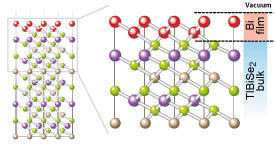

05/25/2015

Adapted by permission from Macmillan Publishers Ltd: Nature Communications (Ref. 1), copyright (2015)
AIMR researchers have shown for the first time that the unique conduction properties found on the surface of materials known as topological insulators are transferred to ultrathin metal films in contact with them1.
Topological insulators are exciting new materials that are electrically insulating in their interior but simultaneously support the flow of electrons on their surfaces. They are highly promising for use in the emerging field of spintronics because, unlike in conventional conductors, the spins of electrons traveling on the surface of a topological insulator are unaffected by defects or non-magnetic impurities.
The combination of a topological insulator and a conventional insulator, such as air, has been widely studied as a result of surface conduction that occurs when the two types of materials are in contact. In contrast, the interaction between a topological insulator and a metal has not been investigated in much detail, despite the importance of this system for practical devices.
Now, Seigo Souma, Akari Takayama and Takashi Takahashi at the AIMR in Tohoku University, together with other researchers from Tohoku University and collaborators at Osaka University, have explored the interface between a topological insulator and a bilayer metal film. In particular, they used spin- and angle-resolved photoemission spectroscopy to probe a bilayer film of bismuth on the topological insulator TlBiSe2.
Their measurements revealed that intriguing electronic states on the surface of the topological insulator migrate to the bismuth film (see image). Since these measured states have half-integer spins and conform to the Dirac equation, they can be regarded as Dirac fermions. Theoretical calculations suggest that the migration results from the strong spin-dependent mixing of electronic wave functions that occurs at the interface.
“We found that, in sharp contrast with conventional wisdom, when a topological insulator is interfaced with a metal, a large portion of the Dirac fermions in the topological insulator are transferred to the metal,” explains Souma.
This demonstration points to a new avenue for manipulating the topological properties of materials. “For example, it may be possible to enhance the performance of a metallic spintronic material by imparting it with topological protection,” says Souma.
The researchers intend to investigate the effect further. “We will fabricate metal thin films with various thicknesses on topological insulators and then characterize them using spin-resolved angle-resolved photoemission spectroscopy,” says Souma. “We are also interested in forming various exotic metals, such as ferromagnets and superconductors, on topological insulators to see how the electronic state of Dirac fermions evolves when coupled with specific orders in materials.”
Shoman, T., Takayama, A., Sato, T., Souma, S., Takahashi, T., Oguchi, T., Segawa, K. & Ando, Y. Topological proximity effect in a topological insulator hybrid. Nature Communications 6, 6547 (2015). | article
This research highlight has been approved by the authors of the original article and all information and data contained within has been provided by said authors.